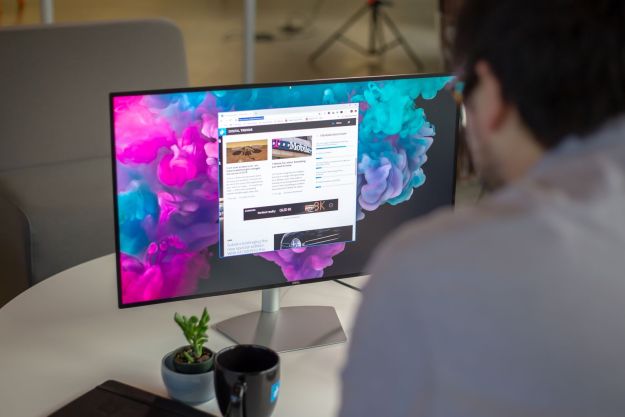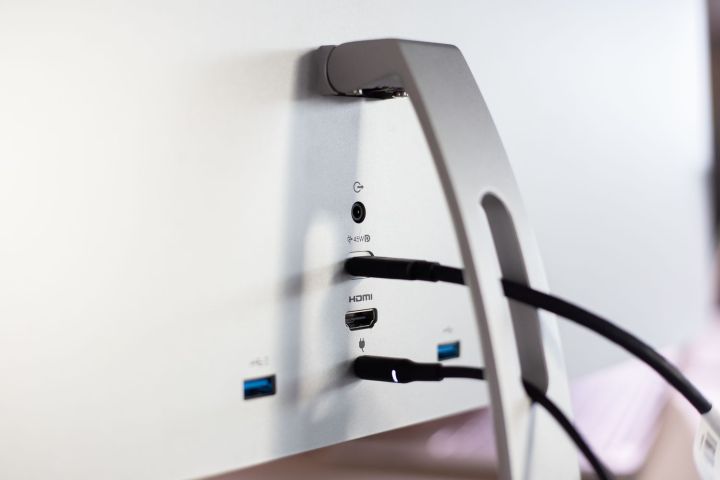
- Beautiful, bezel-less design
- Thin and light cabinet
- USB-C enables hub functionality
- Bright, HDR-ready visuals
- Wide color gamut
- Limited adjustability
- Gamma is slightly off
Monitors are too often boring. Usually made of plastic with large cabinets, thick bezels, and gaudy stands, they’re often meant to blend in. Not stand out.
Then there’s the Dell 27 USB-C Ultrathin.
Dressed in aluminum and sleek as hell, the Ultrathin is a new breed of Dell monitor. It’s not 4K or ultrawide, but instead focuses as much on the framing around the display as the panel itself. $420 (originally $550) is more than you might want to spend on a monitor, but if you want more than a basic work monitor, read on. The Dell Ultrathin 27 is something special and is arguably one of the best monitors out now.
Undoing design trends
While we demand our laptops, smartphones, and other gadgets look as good as they function, monitors often get a pass. The Dell 27 USB-C Ultrathin undoes that trend.
The back of the monitor resembles the Dell XPS laptops. It’s a clean, aluminum curvature, marked by a reflective, silver Dell logo. From there, the gentle curve of the stand extends down to the base. Again, it’s all aluminum here — no random strips of plastic or creaky panels. Dell stripped away the frills with this design, and it feels both modern and elegant. The small stand might look flimsy, but holds the weight of the screen well, which cuts down on the wobble. The hole in the stand won’t hide your cables completely, but it will at least keep them clean and managed.
Our only complaint with the stand is its lack of adjustability. You gain a healthy amount of up and down tilt adjustment, but that’s it. There’s no height, swivel, or pivot adjustment. You’ll have to look to the Dell UltraSharp or the HP Z-series monitors for those.
The design shines on two primary features of its namesake; ultrathin and USB-C. The “Ultrathin” aspect is its most striking. The cabinet measures 1.1 inches at its thickest and 0.2 inches at its thinnest. It may not be the thinnest monitor to ever exist, but it’s thinner than an iPhone X at its smallest. That’s impressive. While you’ll spend most of your time staring at the front of it, that won’t stop coworkers from stopping by your desk to compliment it.
Related
The design adds an unexpected convenience. This monitor is light. We noticed the weight as soon as we pulled it out of the box. At a petite 11.4 pounds, you won’t strain a muscle trying to reposition it on your desk, or even carry it across a room.
And the Ultrathin design doesn’t stop with the cabinet. It also applies to the bezels, which take a cue from Dell’s XPS laptop design. They’re far from your average display borders and they help focus all the attention on what’s happening on the screen.
One transformative port
USB-C is a key feature of this monitor. It’s even in the name. The presence of a Thunderbolt 3/USB-C port means you can grab video from your laptop and charge it all at once. It might seem like a small matter, but it makes the monitor useful hub and adds a lot of value. Quality USB-C docks start at $50 and can soar above $200.

Other ports include two USB-A 3.0 downstream ports, an HDMI 2.0 port, and a 3.5mm headphone jack. This monitor isn’t targeting gamers, so we’re not surprised to see a mini-DisplayPort or second HDMI port to be left off. The back-firing position of these ports means wall-mounting the display might be more difficult but makes accessing the ports easier.
Dell also offers the less expensive S2719DM, which is the exact same display, minus the USB ports.
Easy on the eyes
This monitor’s menus feel as carefully laid-out as its design elements. It has four menu buttons along the bottom of the frame, followed by a lit-up power button that feels different for less accidental presses. You’re two clicks away from brightness control, which is crucial. You can also quickly hop into a few different preset modes like ComfortView, Movie, Game, Warm, and Custom. The Standard view looks the best, obviously, though ComfortView is nice for dark rooms, especially toward the end of a long work day.
The larger menus are easy to navigate through, and we found it simple to get familiar with quickly. There aren’t a ton of options to play with, but you can change contrast, sharpness, input color format, and even set up some shortcut keys.
This is exactly the kind of menu we like to see. Simple, customizable, and not horrendously ugly.
An HDR standout
If the Ultrathin retained its super-sleek design but lacked a quality panel, it wouldn’t mean a thing. Fortunately, the thin frame is just the icing on the cake. The screen itself is a 2,560 x 1,440 IPS LED edge-lit display with a 16:9 aspect ratio. Those are all standard specifications these days. The Ultrathin is also not a gaming monitor, meaning it has a standard 60Hz refresh rate (though it does include support for AMD FreeSync).
So, where does the Dell Ultrathin stand out? Well, where it counts. Image quality.
You won’t want to sit too close when its brightness is maxed out.
The first thing to mention is brightness. You won’t want to sit too close when it’s maxed out. We measured it at 418 nits at 100 percent brightness, which makes it one of the brightest desktop monitors we’ve ever tested. It’s ideal for brightly-lit office settings. The only brighter monitors are the panels included in high-end all-in-ones like the Surface Studio 2 or 5K iMac.
That extra brightness is also helpful for utilizing its HDR capabilities. The monitor meets the VESA DisplayHDR 600 standard, meaning you’ll see the high contrast and vibrant colors of HDR in movies and games. Admittedly, HDR content remains a bit slim for the PC, but movies and games that support it look fantastic on the Dell Ultrathin monitor.
When it comes to color, there’s even more to be excited about. The Dell Ultrathin has a surprisingly wide color gamut, hitting 100 percent of the sRGB color space and an impressive 84 percent of AdobeRGB. Those are some very high numbers, especially for a monitor that isn’t specifically designed for creative professions, like the HP DreamColor monitors. Well done, Dell.
Image quality isn’t perfect, however. The contrast ratio of 780:1 is good, but not excellent. It beats the Dell P2715Q, but you’ll find higher ratios on monitors like the BenQ EX3501R. Also, the gamma reading was slightly off at 2.4. We’ve seen worse, but it does mean images can appear ever so slightly darker than they should. Even so, we were able to follow the action well in dimly-lit movies like Solo: A Star Wars Story.
Post-Calibration
The Dell Ultrathin, for the most part, ships great out of the box. That’s just what we like to see. The couple of weakness it has, such as in gamma or color accuracy, can be corrected in calibration.
Using our Spyder5 tool, we managed to pull down the color accuracy from 2.49 to 1.49 and the gamma down to 2.3. The Ultrathin improves with calibration, so if you’re someone who relies on the precision and performance of your monitor professionally, we recommend calibrating this screen.
Our Take
Ultrawide and 4K monitors may have taken the limelight, but standard 27-inch monitors don’t get much more exciting than the Dell Ultrathin 27. It’s thin, light, and sleek — everything you want to match something like a Dell XPS laptop or MacBook. Better still, it’s equipped with a high 1440p pixel resolution and great image quality. It may not be as flashy as some other monitors, but Dell has nailed the basics.
Are there any alternatives?
The first alternative comes from within Dell’s own lineup: The UltraSharp 27 USB-C monitor. It’s not quite as sleek (and it’s a bit more expensive), but it comes with some extra adjustment options for those that need the flexibility.
Another option might be the $400 Samsung SH850, which is also 1440p, has thin bezels, and features a USB-C connection. It’s nowhere near as thin or sleek as the Dell, though.
Lastly, there are a number of great 4K or ultrawide monitors available as well, such as the 34-inch Samsung CF791, though it’s quite a bit more expensive at $750.
How long will it last?
The Dell 27 Ultrathin USB-C monitor should last you many, many years. That’s just what you want in a monitor. The USB-C port, 1440p resolution, and HDR support should keep you up to date for many years, regardless of changing technologies and formats.
Even better, the monitor comes with a three-year “Advanced Exchange Service” and limited hardware warranty. That’s standard for monitors, matching companies like HP or Asus, but it’s better than LG, which only offers a one-year warranty.
Should you buy it?
Yes. Not only is the Dell 27 Ultrathin USB-C monitor the best of its kind, it’s one of the best monitors you can buy, hands down.
Looking for more options? We’ve pooled together the best monitor deals for you to check out.









